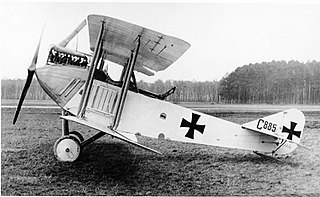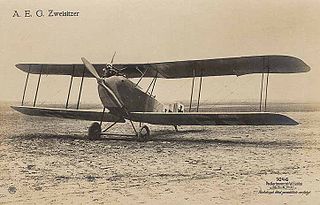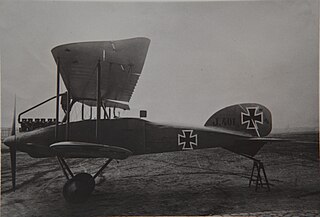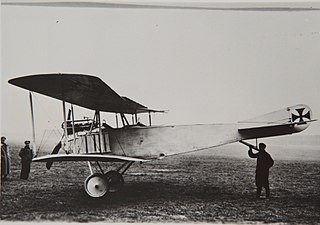Related Research Articles

The AEG B.I was a German two-seat biplane unarmed reconnaissance aircraft produced in very small numbers in 1914. It formed the basis for the more successful B- and C-type aircraft from AEG.

The AEG B.II was a two-seat biplane reconnaissance aircraft produced in small numbers from 1914. It was a slightly smaller version of the B.I and proved more successful. They were used in limited numbers throughout 1914 to 1915, but were quickly replaced, as they were often derided for lack of speed and armament.
The AEG C.I was a two-seat biplane reconnaissance aircraft produced in small numbers from March 1915 by the German company Allgemeine Elektrizitäts-Gesellschaft (AEG). It was essentially an AEG B.II armed with a single 7.92 mm (.312 in) Parabellum or Bergmann (rarely) machine gun mounted at the rear of the cockpit for the observer and a more powerful engine. The Benz engine increased maximum speed to a more respectable 130 km/h (81 mph). By October 1915, it had begun to be replaced by the AEG C.II.

The AEG C.II was a German two-seat biplane reconnaissance aircraft produced in small numbers from October 1915. It was a slightly smaller version of the C.I with better performance, redesigned cockpit for both pilot and observer/bombardier, new rear mounting for a 7.92 mm (.312 in) Parabellum MG14 machine gun, and the ability to carry four 10 kg (22 lb) bombs for light attack duties.

The AEG C.IV was a two-seat biplane reconnaissance aircraft designed and produced by the German aircraft manufacturer Allgemeine Elektrizitäts-Gesellschaft.

The AEG Dr.I was a triplane fighter of World War I, based on the D.I. Only a single prototype was built and its poor performance meant that no production ensued. The Dr.I was a Dreidecker (triplane) variant of the D.I and had been inspired by a Sopwith Triplane that had been captured intact. A number of proposals for fighters with comparable characteristics were put forward, and AEG's contribution to the program appeared in October 1917. Other than the triple wing it was a D.I, the aircraft had the same fuselage, engine and twin gun armament of its earlier brethren.

The AEG G.IV was a biplane bomber aircraft designed and produced by the German aircraft manufacturer Allgemeine Elektrizitäts-Gesellschaft. It saw action during the First World War with the Luftstreitkräfte.

The Albatros C.I,, was the first of the successful C-series of two-seat general-purpose biplanes built by Albatros Flugzeugwerke during World War I. Based on the unarmed Albatros B.II, the C.I reversed the pilot and observer seating so that the observer occupied the rear cockpit which was fitted with a ring-mounted 7.92 mm (0.312 in) Parabellum MG14 machine gun.

The Albatros B.II, was an unarmed German two-seat reconnaissance biplane of the First World War.

The Fokker E.III was the main variant of the Eindecker fighter aircraft of World War I. It entered service on the Western Front in December 1915 and was also supplied to Austria-Hungary and Turkey.

The Albatros B.I, was a German military reconnaissance aircraft designed in 1913 and which saw service during World War I.

The Albatros J.I was a German armored ground attack airplane of World War I, produced in 1918.

The Aviatik B.I is a German two-seat reconnaissance biplane designed and built by the Automobil und Aviatik AG company, who until then had produced copies of French designs.

The Friedrichshafen G.I was a prototype heavy bomber aircraft that was built in Germany by Flugzeugbau Friedrichshafen in 1915. It was Karl Gehlen's first design for the company, and although it was not produced in quantity, it provided the foundation for the later, highly successful bombers culminating in the G.III.

The Friedrichshafen G.II was a heavy bomber aircraft that was designed and manufactured in Germany during World War I by Flugzeugbau Friedrichshafen. The plane was used by the Luftstreitkräfte for tactical and limited strategic bombing operations.

The LVG B.I was a 1910s German two-seat reconnaissance biplane designed by Luft-Verkehrs-Gesellschaft for the Luftstreitkräfte.

The Albatros B.III,, was a German World War I reconnaissance biplane, built by Albatros Flugzeugwerke as the Albatros LDD.
The Siemens-Schuckert R.I was a bomber aircraft built in Germany during World War I. It was originally ordered as the Siemens-Schuckert G.I prior to the German Inspectorate of Flying Troops adopting the "R" classification for multi-engine aircraft in late 1915. Some sources refer to the aircraft as the Siemens-Schuckert Steffen R.I, including the name of the brothers that designed it.

The AEG Wagner Eule was a German reconnaissance aircraft built in 1914 by Allgemeine Electricitäts Gesellschaft.
References
- ↑ Wilberg, Thomas. "The Virtual Aviation Museum". Germany: www.luftfahrtmuseum.com. Archived from the original on 15 January 2003. Retrieved 15 November 2011.